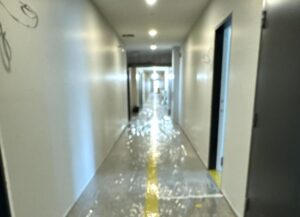Whether soft with paint or bright with wallpaper, walls frame the life of the household — but too often, they also wear it! Daily living can easily deposit smudges, smears, and fingermarks (especially when there are small children involved), marring the beauty of your home’s walls and woodwork.
Keep your home clean and gleaming with these handy tips on how to clean walls and wallpaper!
How to Clean Painted Walls
On your mark, get set, prep! Cleaning painted walls is a big job, so be prepared. Start by pushing your furniture to the center of the room, and lay down old sheets or canvas drop cloths to catch soapy drips. Avoid plastic tarps; they don’t absorb water and become slippery when wet. To protect your hands and to remind you where pictures belong, cover picture nails with a chunk of household sponge.
Then, gather your wall washing tools. You will need:
- A lamb’s wool duster
- White cleaning cloths
- A natural sponge (avoid coloured sponges, since they can deposit dyes on light-colored walls)
- Two buckets – one filled with cleaning solution and one filled with clear water for rinsing.
- Rubber gloves or washing-up gloves protect your hands (be sure to turn up glove cuffs to help contain drips)
- A step stool – this makes life easy when you need to reach up to the ceiling
- Tools with handles to keep wall cleaning sessions safe.
Ready to Clean
In one bucket, mix the wall cleaning solution. For normal soil levels, try a mild detergent solution, consisting of:
- 1 gallon (4 liters) warm water, to which you add
- A good squeeze of liquid dishwashing detergent
For more heavily soiled walls, you’ll need a stronger alkali solution, but spot-test any cleaning mixture first to ensure it won’t remove or lighten paint. Add all of the following to your bucket and give it a good stir before you start:
- 1 gallon (4 liters) warm water
- 1 cup (250ml) clear non-sudsing ammonia
- 1 cup (250ml) white vinegar
- 1 cup (250ml) washing soda (borax)
The second bucket should hold clean water, to be used for rinsing. Change the water if it starts to look dirty as you work your way around the room.
Ditch the Dust
Dust is always easier to remove than mud, so remove any loose dust before bringing moisture into the mix. Circle the room with the lambswool duster, wiping walls and woodwork from the top down. Take the duster outside and spin the handle between your palms to release the dust.
Alternately, use a vacuum cleaner’s extension wand and bristle brush head (used for upholstery) to remove dust and cobwebs from walls and woodwork.
Bottoms Up
Drips are inevitable when washing walls. Should they run down dry, dirty surfaces, they’ll then dry-and create long muddy stains. Avoid drip issues by washing walls from the bottom up. Yes, you’ll drip onto already-cleaned areas, but the solution will be a quick swipe with a sponge, rather than a tough cleaning job.
Dip the natural sponge into the bucket of cleaning solution, and rub the wall gently to avoid removing paint. Work in small areas, washing and then using the sponge to rinse the area with clean water. Lastly, blot excess moisture with white cleaning cloths.
Take it to the End
When washing walls, always wash the entire wall, bottom to top and side-to-side. If you need a breather, take it between walls, not in the middle. Stopping the job before you finish the entire wall can cause “wash marks”, which is a wave effect caused by stop-and-go wall washing. Avoid this by washing an entire wall in a single session, using the same type and strength of cleaning solution.








